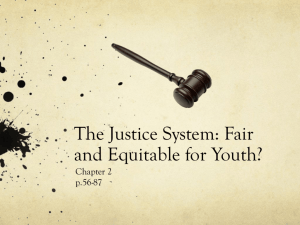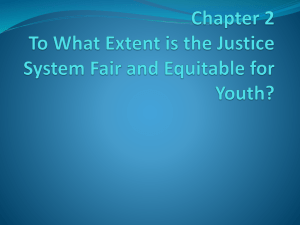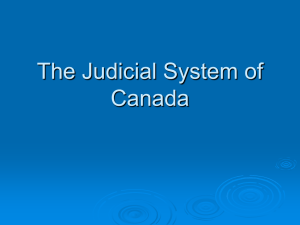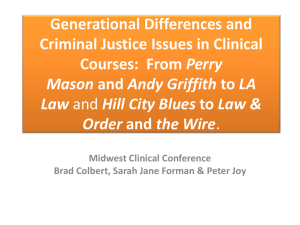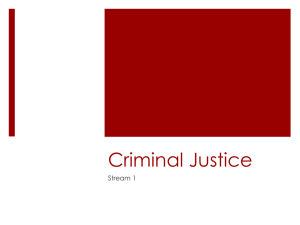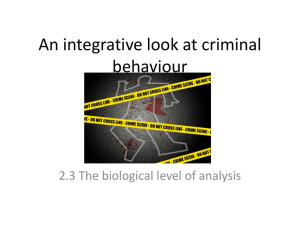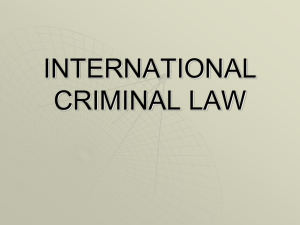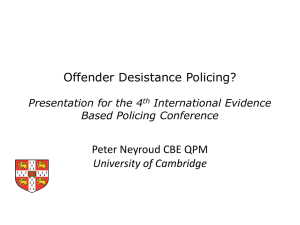To What Extent is the Justice System Fair and Equitable for Youth?
advertisement
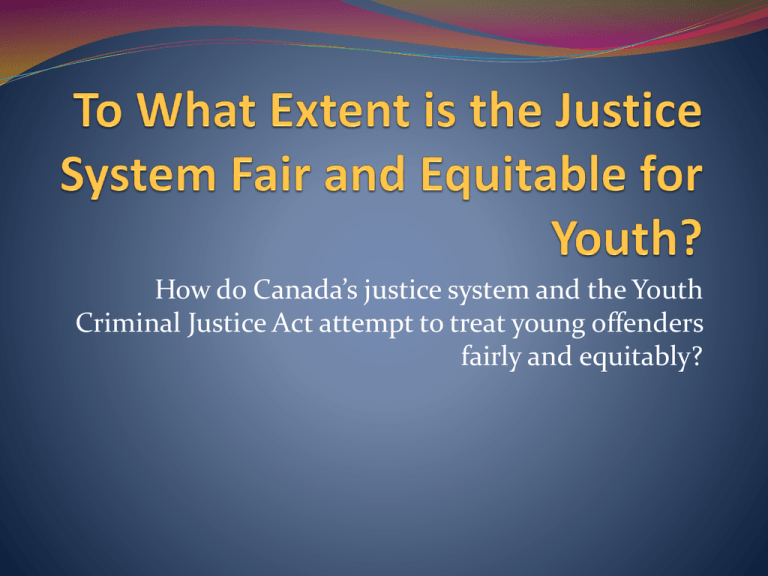
How do Canada’s justice system and the Youth Criminal Justice Act attempt to treat young offenders fairly and equitably? Introduction Imagine you saw the following news bulletin: To all Canadian citizens: Effective immediately, a new law has been established by the federal government to curtail the increase of youth crime, particularly gang violence, in Canada. All youth, ages 12–17, will be required to inform their local government agent about any travel outside of their community. This is to reduce the problems related to the recent rise of gang violence in Canada. It is the belief of the federal government that youth are central to this issue. The gangs are training youth to move illegal goods from area to area. The controlled movement of youth should assist in the reduction of violence and contact of gangs from community to community. Please be advised that this new law will be in place indefinitely. The Government of Canada Consider your initial reaction to this bulletin. You may be questioning how fair this new law is; the idea that not every citizen in Canada is treated the same. Or, you might be concerned about the law being equitable, taking into account that this new law affects all youth, even those who have nothing to do with gangs. What do you think fair and equitable mean? Let’s look at some multimedia to help your understanding. What is fair and equitable? Would you accept the decision of the federal government and follow the new law? Is it fair and equitable? Are there other options that you might be able to consider? Justice System for Youth Imagine this scenario: Two youth are caught committing the same crime. The first youth remains anonymous when the crime appears on the front page of the local newspaper. The second youth has both a picture and a name published on the front page of another local newspaper. How these events will affect both the identity and future quality of life of these two young offenders? A very important part of governance in Canada is the justice system. An important part of creating laws is ensuring that they are fair and equitable for all Canadians. The Supreme Court ensures laws are just and fair and do not infringe on the Charter of Rights and Freedoms. Protecting youth is an important part of Canada’s justice system. The Youth Criminal Justice Act was created to deal with youth who break the law, whereas adult offenders are tried under the criminal code. Let’s find out your thoughts on youth justice before we get into the chapter by completing a prequiz! In this chapter, we will discuss how the Justice System is fair, equitable, and how it impacts identity and quality of life. Specifically, we will look at the YCJA, since it directly relates to you. Justice System = institutions and procedures for applying laws in society. How effectively does it protect society, the innocent, and ensure those who break the law face proper consequences? Let’s think… What do you know about the justice system? Think about TV court dramas. What are some plot lines? Think about how justice in these plots are portrayed. Do you think they are accurate interpretations? Do you think these examples have fair, just or equitable conclusions? Read pg 57 in your textbook. Be prepared to answer the three questions on the page. What is the intention of the Youth Criminal Justice Act? The Youth Criminal Justice Act (YCJA) replaced former legislation dealing with youth crime, the Young Offenders Act, in 2003. Generally, the YCJA focuses on rehabilitation of young criminals but also carries heavier punishment for youth convicted of serious and violent crimes. The YCJA aims to help young people who get into trouble with the law to understand how their actions affect other people and deter them from committing crimes again. True Story Look at the picture at the bottom of pg 60. What do you think would be fair and just consequences? Read pages 61-63 in your textbook about a girl who gets arrested. Prepare point form thoughts based on the question at the end of pg 63. Did you think of… Pg 63: Recognition that what she did could have led to far more serious consequences, such as jail time and a record. Had she received a record, many of the rights we take for granted, such as being about the travel to other countries, would be taken away. Life lessons include being aware of the consequences of your actions. One seemingly small mistake can have repercussions for a lifetime. Comparing youth justice and adult justice. Youths are treated differently than adults by Canada’s justice system. All youth who come into conflict with the law are dealt with under the under the Youth Criminal Justice Act (YCJA). All adults must face the law as it is defined in the Criminal Code of Canada. These two laws have similarities and differences. The consequences for offenders are meant to be fair and equitable. Comparing youth justice and adult justice. Read page 64. Using a Venn diagram, compare the YCJA and the criminal code of Canada. Answer the two BTQ on the page. Did you think of… Is a separate justice system needed? Young people do not understand what they are doing in the same way adults do. Putting young people in jail with older criminals does not help them change for the better. It not only jeopardizes their well-being, but can lead to acquiring habits that would affect them as an adult. Did you think of… How would a criminal record affect your quality of life and identity? A record can permanently bar you from some jobs, volunteer positions, and travel to some countries. You might not be able to become a (lawyer, teacher, police officer) as you would like. Some people might not want to be your friend any longer. Factors that determine consequences Look on pgs 66-67. Make a list of all the people involved in making sure that justice for youth is equitable. Include their roles. Let’s look at another flow chart here. Assignment: 1. Complete the three BTQs on pgs 66-67. 2. Read pg 68. Summarize the main factors in determining consequences. Answer the BTQ. 3. Read pg 69 and complete the BTQ. Did you think of… Pg 66; Two crimes; same might be consequences? I think it would be unfair if two offences were not treated equally. I recognize that people are different so the decisions may vary, based on personalities of authorities, where they live, how the community feels about justice. Young people live in different areas of the country. The circumstances of a young offender living in the Yukon might be more difficult than someone living in Banff. What would best help each offender would be very important in the decision. Did you think of… Pg 66; Is it fair and equitable justice? Canadians are more concerned about rehabilitating young offenders than punishing them. Justice can involve many other professionals, not just police officers, lawyers, and judges. There are social workers, mental health workers, Elders, and volunteers who help rehabilitate young people. Did you note that this system gives more rights to the young offender than to the victim? What are the objectives of the YCJA? Read about the main objectives of the YCJA on pg 70. Who does each objective affect the most: young offenders, victims, or everyone in society? Why? Create a chart like the one below to organize and reflect on your ideas: Objective Who it Affects the Most Reasons Why Are the consequences appropriate? Let’s think… Let’s look at the graph on pg 71 and answer the main question. What further questions would you like to ask about this chart? What about rural vs. urban crime? What about the number of offences based by age? Gender? What are the types of crimes youth are committing? Are the consequences appropriate? Turn to pgs 72-73. Four newspaper articles are represented here. In your row, decide who is going to read which article. Identify the MAIN POINT of the article. Answer the BTQ for your article. Are the consequences appropriate? Lets read and take point form notes about a 12 year old girl who was convicted of killing her family. Teen receives sentence for killings Teen gets more freedom DEBATE: Do you think the consequences were fair and appropriate for the conviction? Do you think her name should be released? Then? Now? Reading Political Cartoons They reveal an opinion about a topic. Seen as a persuasive way of communicating. Most cartoons attempt to use humor about serious topics within politics. Political cartoons focus around: -public figures -government decisions -breaking news events Reading Political Cartoons Cartoons establish situations They exaggerate aspects of events to make a point about certain issues. Cartoons portray a message the author is trying to get across. Let’s look at the political cartoon on pg 74. What is the cartoon suggesting? How do you know? What are the clues? Assignment: Search for a political cartoon on an issue in the news. Be prepared to explain: The background of the issue What the cartoon is showing Summarize the cartoon in one sentence Some resources to use: Edmonton Journal learnalberta.ca; click on Online Reference Center zone.artizans.com YCJA and You SO….How does the Youth Criminal Justice Act protect me? The Youth Criminal Justice Act protects young people who commit a crime. The act ensures that agencies and officials in the justice system provide fair and equitable justice. The main objectives of the act are to reduce crime and provide justice for the youth, the victims, and for the community as a whole. How the police or the court system determines the consequences for a young offender has an influence on his or her identity and quality of life. Ensuring that youth are given a chance to redeem themselves in as many cases as possible is an important aspect of the YCJA. Let’s check our knowledge about the YCJA by playing some games! Video time! Let’s watch the video on Youth Justice; A New Approach.
